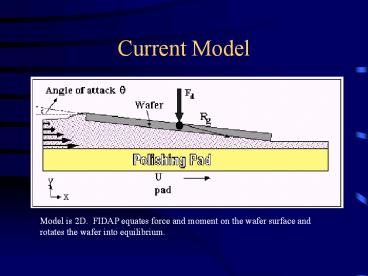Current%20Model - PowerPoint PPT Presentation
Title:
Current%20Model
Description:
Comparison with Experimental Results Model predictions compared with fluid film ... Pad Deformation Model Two existing ... approach is more ... – PowerPoint PPT presentation
Number of Views:26
Avg rating:3.0/5.0
Title: Current%20Model
1
Current Model
Model is 2D. FIDAP equates force and moment on
the wafer surface and rotates the wafer into
equilibrium.
2
Comparison with Experimental Results
- Model predictions compared with fluid film
thickness and pitch angle results from Lu et al
(2001) - Results on same order
- Film thickness differs by constant of about 20 ?m
- difference due to DELIF technique? - Angle of attack is on same order as
experimentally measured value
42
Tufts University Dept. of Mechanical
Engineering MS Thesis Defense Oct 17, 2002
3
Adding Material Removal
- A method to determine removal rate must be
determined. - Possible models include
- Modified Prestons law
- Surface stress model
- Abrasive and chemical wear model
- Arbitrary user-defined model
4
RR Models
- A modified Preston model is probably best.
- Should provide flexibility for various problem
types. - Easiest way to obtain removal rate on global
scale. - Current research on Preston coefficients for CMP
exists to some degree. - Options could become limited depending on the
method used in FIDAP to implement removal rate of
the wafer.
5
Current Work Computer Set-up
- Current version of FIDAP (8.7) is not compatible
with the existing models created in the earlier
version FIDAP (8.52), although it should be. - Converting model databases and subroutines this
month. - Currently trying to working with FIDAP technical
support to remedy FORTRAN compiler issues on new
university UNIX server.
6
Project Priorities Material Removal or Pad
Deformation?
- Should we pursue pad deformation modeling in lieu
of removal rate? - If pad deformation experimental envelope and
simulations should be coordinated
7
Initial Strategies for Pad Deformation Model
- Two existing FIDAP approaches
- Model pad as a flexible thin film
elasticity(vein wall example) boundary
condition to fluid problem - Rigid body movement full model of pad
- First approach is more compatible with previous
modeling efforts - Currently running simpler test cases with
standard FIDAP model while compiler problem is
upgraded































